NIOSH in Cincinnati – A Pictorial History, Part II
Posted on byNIOSH in Cincinnati – How did it happen, and what has it looked like?
How did federal industrial hygiene and occupational (and environmental) health research and service come to Cincinnati, and why did it stay? Interconnected stories of events that occurred, locations and buildings where they happened, cultural elements that developed, and artifacts that remain, speak to this question, providing evidence and glimpses of federal staff in Cincinnati investigating occupational health concerns, a vital part of the history of NIOSH today. This is the second blog in a two-part series on the history of NIOSH in Cincinnati.
NIOSH Beginnings in Downtown Cincinnati
With the signing of the Occupational Safety and Health (OSH) Act in December 1970, the U.S. Public Health Service (PHS) Bureau of Occupational Safety and Health (BOSH), the immediate predecessor of NIOSH, began to report directly to the Health, Education and Welfare (HEW) Assistant Secretary for Health and Scientific Affairs. BOSH was briefly in HEW’s Health Services and Mental Health Administration and then reorganized into NIOSH in May 1971. BOSH director Dr. Marcus Key was appointed as the first NIOSH Director. NIOSH was placed in HEW’s Center for Disease Control (CDC, singular then) in 1973, and NIOSH headquarters were moved from Rockville, MD to Atlanta, GA in 1981. NIOSH now reported to the CDC, which reported to HEW. The pros and cons of the organizational change were debated at the time, as they sometimes are today.

“Most NIOSH research, technical assistance, and training activities under the [OSH] Act are conducted at NIOSH facilities in Cincinnati, Ohio,” according to The President’s Report on Occupational Safety and Health, 1972, adding that NIOSH in Salt Lake City conducted additional research and technical assistance, and the NIOSH Appalachian Center for Occupational Safety and Health, Morgantown, WV carried out Coal Mine Health and Safety Act responsibilities and those of its respirator Testing and Certification Laboratory. From NIOSH beginnings through the early 1980’s, it operated simultaneously in several downtown Cincinnati locations. One was 1014 Broadway, which NIOSH predecessor agencies had occupied since 1950 (see NIOSH in Cincinnati – A Pictorial History, Part I). NIOSH also established offices and laboratories in the Potter Stewart Federal Courthouse/U.S. Post Office and the J.W. Peck Federal Building, which are across the street from each other at 5th and Main Streets.
Paula Fey O’Connor, retired chemist, began work at NIOSH in 1978 at 1014 Broadway and recalls that the NIOSH atmosphere was “exciting,” perhaps because NIOSH was so new, she reflected, and that collaborating, sharing information, and other synergy among staff may have been the result of scientists and technicians working in close proximity to each other and even having to walk through others’ labs just to get around the building. She also enjoyed walking from 1014 Broadway to the other NIOSH downtown locations for business.
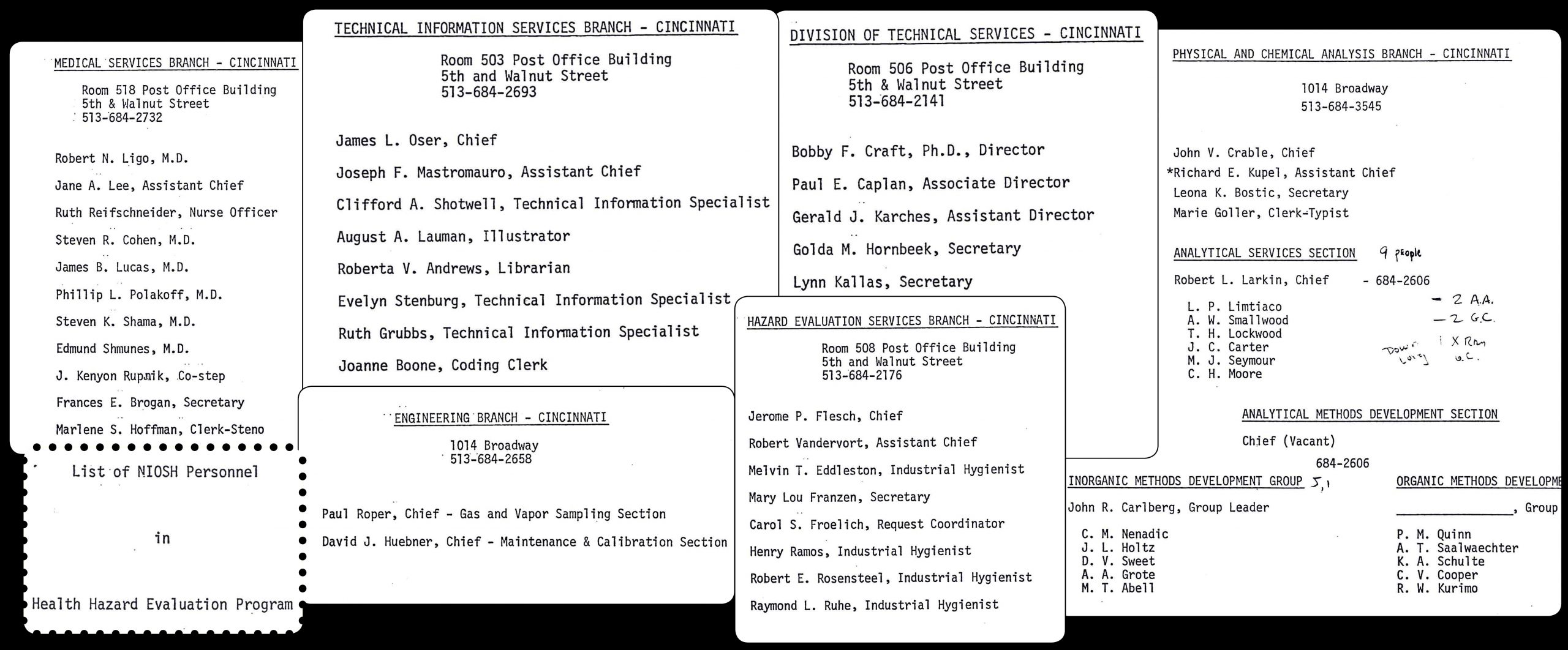
From NIOSH HHE Procedures Manual, 1972. Credit: NIOSH/DFSE/HETAB
An example of the interrelatedness and synergy of NIOSH staff downtown can be seen in the 1972 Health Hazard Evaluation [HHE] Program personnel listing. HHE personnel worked at 1014 Broadway and in several areas of the Post Office Building (now the Potter Stewart Federal Courthouse). The Program then was in several NIOSH branches, some in different divisions, giving evidence of its breadth and depth. The HHE Program, which was specifically mandated by the OSH Act and given increasing importance by third NIOSH director Anthony Robbins (1978-1981), appears early on to have had structural strength for its responsibilities.
A main focus of first and second NIOSH directors Marcus Key (1971-1975) and John Finklea (1975-1978) was production of Criteria for a Recommended Standard reports, which were highly respected monographs of the toxic properties of various individual workplace substances, known as “criteria documents.” Many criteria documents concluded by recommending epidemiological study of the substance to understand its health effects and relation to workplace exposure. NIOSH-Cincinnati was building its epidemiological and statistical capacities in the 1970’s, and its new epidemiologists were reading the criteria documents. They realized they had the unique opportunity to identify substances of concern and conduct needed research. Such was the case for Robert Rinsky, Peter Infante and team, who designed and conducted landmark studies of the risk of benzene exposure and leukemia death. 1960’s advances in personal air sampling greatly added to the research of this time, as industrial hygienists could now assess exposures more precisely. Early criteria documents served as the impetus for NIOSH epidemiological studies of asbestos, beryllium, and cotton dust, to name a few, and the vinyl chloride recommended exposure standard resulted from an important 1974 NIOSH study.
Ridge Avenue Facility Before PHS

The NIOSH facility at 5555 Ridge Avenue, now the NIOSH Alice Hamilton Laboratory for Occupational Safety and Health, was designed as the rehabilitative national Idento-Tag manufacturing facility of the Disabled American Veterans (DAV), a not-for-profit charity organization. Ground was broken and the building’s cornerstone laid in 1953. Built as one large story with an open floor plan and full basement, it allowed easy mobility for up to 400 veterans at a time, with a huge cafeteria, bowling alley and baseball diamonds. Here veterans made made Idento-Tags from 1955 to 1964. Idento-Tags were miniature replicas of vehicle owners’ license plates with DAV’s mailing address on the back, made to attach to keychains. When lost keys with Idento-Tags were found and the finder dropped them in a mailbox, DAV received and sent them back to the owner, with an enclosed envelope for donations.
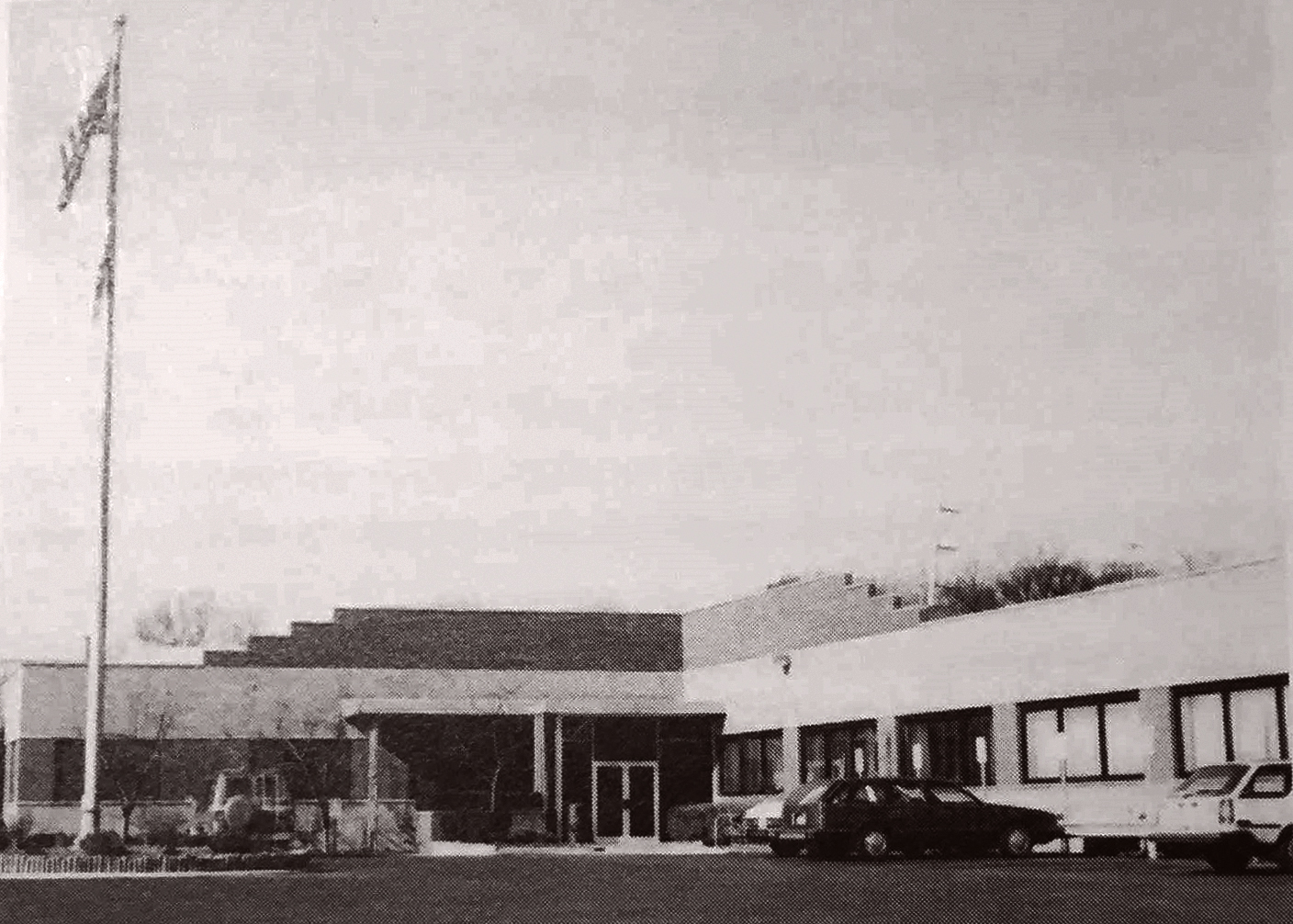
The building was and is architecturally plain. It is set back on its property such that it is hardly noticeable when driving by on Ridge Avenue. Inside, however, gorgeous terrazzo tiles, much like those at the NIOSH Taft Laboratory, were set in the Ridge Avenue building’s cafeteria floor. Although the cafeteria space was later repurposed, some of its three-foot square and larger tiles are visible today as a hallway floor at the front of the building and the hallway of a group of offices informally known as the “Ramazzini Wing” (after the 17th century physician and scholar thought of as the father of occupational medicine). Interestingly, the color and pattern of the linoleum (or vinyl) tiles of the lobby were chosen to match those of the terrazzo.
PHS began leasing space in the DAV Ridge Avenue building for its environmental programs in 1962. Even though PHS had moved to the new, large Taft Sanitary Engineering Center in 1954, its environmental mission and staff grew tremendously in the 1950’s and 1960’s (see NIOSH in Cincinnati – A Pictorial History, Part I), and it needed more space. Some PHS environmental programs and personnel moved to the DAV building and to other locations around Cincinnati.
NIOSH Becomes Sole Occupant of Ridge Avenue Facility
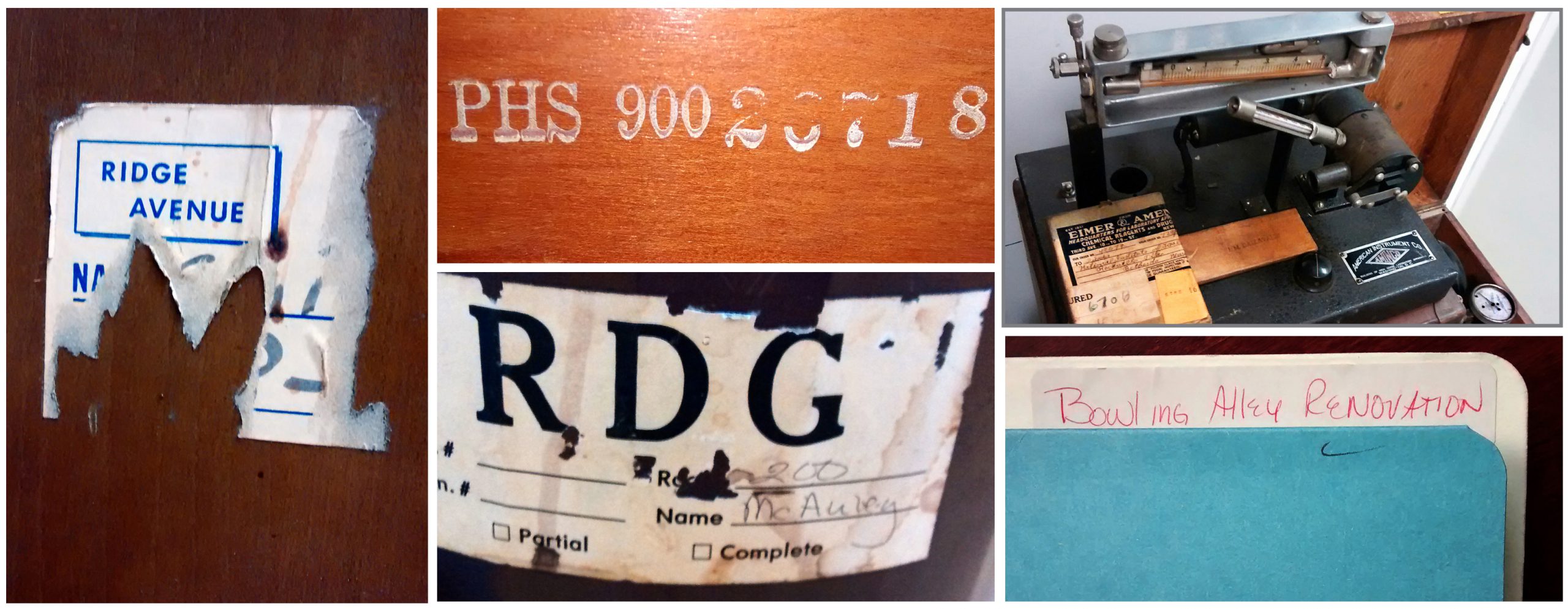
PHS environmental programs were still housed at Ridge after they were reorganized into the newly created Environmental Protection Agency (EPA), around 1970. Many EPA staff stayed at Ridge until after 1976, when they could move to the new EPA Briedenbach Center in the Clifton area of Cincinnati. Meanwhile, by 1973, the entire Ridge Avenue building was leased by federal agencies, including the PHS, EPA, and NIOSH.
For much of the 1970’s, it was uncertain whether NIOSH would remain in Cincinnati. Some retired staff report they delayed buying homes in the area because of this. A measure had been introduced in Congress to reevaluate the Cincinnati location of NIOSH. Some behind this wanted it moved to Chicago. Strongly opposing this were U.S. senators and congressmen of both parties from Ohio, who wanted the over 500 good jobs to stay in the state. The issue was settled in 1978 when the Health and Human Services Secretary rejected further plans to study its location, citing mainly the cost of relocating and buying land elsewhere as outweighing potential benefits of moving.
Despite the national political discussion about whether it would stay in Cincinnati, NIOSH began remodeling the Ridge Avenue facility for its programs in 1976, replacing DAV’s original open floor with individual offices and laboratories. Some Division of Physical Sciences and Engineering operations and staff moved from downtown to Ridge in 1978. Other renovations took longer to complete, and some staff and programs remained downtown. Meanwhile, PHS purchased the Ridge facility and NIOSH became its sole occupant in 1982. Finally, in November 1983, NIOSH-Cincinnati AFGE Local 3840 could report, “Work has been completed in the Basement and Bowling Alley at Ridge. Move of DSHEFS [Division of Surveillance, Hazard Evaluations and Field Studies] employees will be completed by November 5, 1983.”

Many longtime and retired NIOSH staff remember bittersweetly leaving downtown. Those who worked in the Federal Building and Federal Courthouse/U.S. Post Office say they missed the liveliness of downtown, favorite lunch spots, and being able to take a bus to work. However, some say that the 1014 Broadway facility was becoming, or had become, decrepit and that those still working there welcomed leaving it.
Evidence of the Ridge Avenue renovation and the move from downtown can be seen in the Ridge facility today, from furniture and office items bearing original PHS identification numbers and moving stickers to historic PHS Industrial Hygiene Division image and industrial hygiene instrument collections moved or salvaged there, and now managed with care. The Industrywide Studies Branch (now the Field Research Branch) space was remodeled from the DAV basement bowling alley, and every now and then, all these years later, someone will refer to this area as “The Bowling Alley.”
NIOSH Cafeteria Puts Ridge Facility on Cincinnati’s Culinary Map

“If we didn’t get along together, there’d be no business,” Rita Seigle told the Cincinnati Enquirer in 1977, referring to the cafeteria she, her mother Margaret Schmidt, and sister Inge Bickford ran at the federal facility at 5555 Ridge Avenue, then housing Environmental Protection Agency (EPA) and NIOSH employees and later becoming solely a NIOSH workplace. The three women, refugee immigrants from East Germany, honed their skills cooking and working together at several other places in town before beginning operations at Ridge Avenue in 1969. The cafeteria at Ridge was originally named Die Kaffee Kanne, as were their previous endeavors. Five days a week, they came in very early to bake sourdough bread and desserts and cook homemade meals “from scratch” for government employees, their guests, and the public. A condition of their contract with GSA had become that the cafeteria was open to the public. It was a very different time regarding access to and security of federal buildings!
In 1984, Cincinnati Magazine wrote of the cafeteria, with a wry nod to its being at NIOSH, “Witness excellence in the face (or mouths) of bureaucracy – lunch at the outstanding cafeteria at NIOSH on Ridge Road, where the German women who operate this restaurant will make you appreciate the workings of government again.” The magazine lauded the food and its heritage five times from 1977 to 1985, and 5555 Ridge Avenue became a noontime destination around the city, and even for government visitors from Washington, DC. Longtime and retired NIOSH employees fondly shared vivid memories. Ken Wallingford recalls, “I remember the meatloaf sandwiches were on fresh-baked bread and felt like holding a brick!” Frank Hearl says, “The German chocolate cake was to die for!” Others remember eating and visiting with others in the large, windowed first floor space as a welcome, if sometimes guilty, pleasure.
It was not all cherry pie, however. Tastes were changing in the 1980’s toward lighter and less expensive lunches, and as much as they appreciated it, more and more employees didn’t want or couldn’t afford the cafeteria’s fare. NIOSH-Cincinnati AFGE Local 3840 met with Inge and the NIOSH management official about this in 1993 and described the dilemma, “The problem is to find ways to meet employees’ needs for lower prices and new food offerings while maintaining the Bickford family’s tradition of high quality food made from fresh ingredients.” New efforts were not entirely successful, and the NIOSH cafeteria closed in the late 1980’s. By 1989, Inge Bickford, with her mother, had opened a small restaurant not far from the NIOSH Taft Laboratory. It was also well reviewed, especially for its fruit pies! Inge retired in 1994.
Dedication of NIOSH Alice Hamilton Laboratory
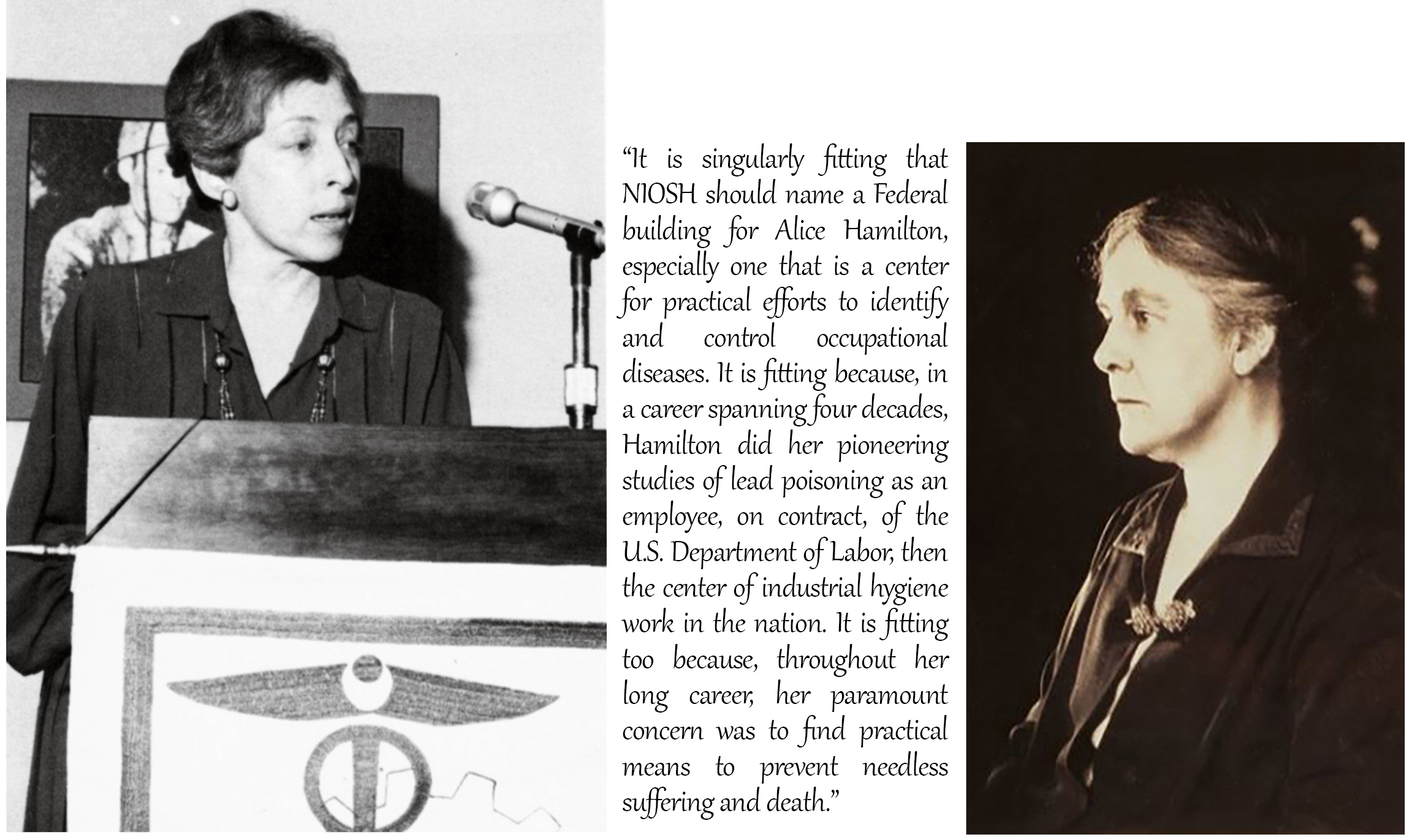
5555 Ridge Avenue was dedicated as the NIOSH Alice Hamilton Laboratory for Occupational Safety and Health on February 27, 1987. Alice Hamilton, MD (1869-1970) was an occupational health leader. She conducted and published landmark studies of the extremely dangerous effects of many industrial substances and processes on the human body, such as lead, mercury, and vibration. She worked with the State of Illinois, national and international public health organizations, and was the first woman on the faculty of the Harvard Medical School. Underpinning her work was what she learned about people who were poor and the problems they experienced, from early in her career when she lived in the Hull House settlement house in Chicago.
The May 1987 special feature Section of the Applied Industrial Hygiene Journal described the dedication of this NIOSH facility:
“The dedication of the NIOSH, Cincinnati, Ridge Avenue facility on February 27, 1987 (the 117th Anniversary of Alice Hamilton’s birth) as the Alice Hamilton Laboratory for Occupational Safety and Health was the eighth federal facility to be named for a woman and the first non-office building facility so named. The ceremonies were led by Dr. Donald Millar, Director of NIOSH. The dedication was performed by Dr. James 0. Mason, Director of the Centers for Disease Control (CDC), with major addresses by Dr. Lorin Kerr, Director Emeritus of the United Mine Workers of America (UMWA), and Barbara Sicherman, PhD, a biographer of Dr. Hamilton.”
NIOSH staff and guests attended the dedication, as did Dr. Marcus Key and Dr. John Finklea, the first two directors of NIOSH, and Phoebe Hamilton Soule, Dr. Hamilton’s niece. A highlight of the event was the unveiling by the Federal Women’s Program of NIOSH of a painted portrait of Dr. Hamilton, which they donated for permanent display in the facility that was now honored to bear her name. It hangs in the lobby today.
Dedication of NIOSH Cincinnati Staff
NIOSH in Cincinnati has operated out of the Robert A. Taft Occupational Safety and Health Laboratory (see NIOSH in Cincinnati – A Pictorial History, Part I) and the Alice Hamilton Laboratory for Occupational Safety and Health for approximately four decades. Both buildings, which date from the mid-1950’s, have remained relatively unchanged over the years. NIOSH, however, continues to change. Staff depart, new staff arrive, leadership changes, research priorities evolve, new collaborations and partnerships are forged, and new solutions are developed and communicated to address persistent and emerging occupational health problems. What has not changed is the dedication of NIOSH staff in Cincinnati, as in all its locations around the nation, to work together in the mission of protecting people’s health in the workplace.
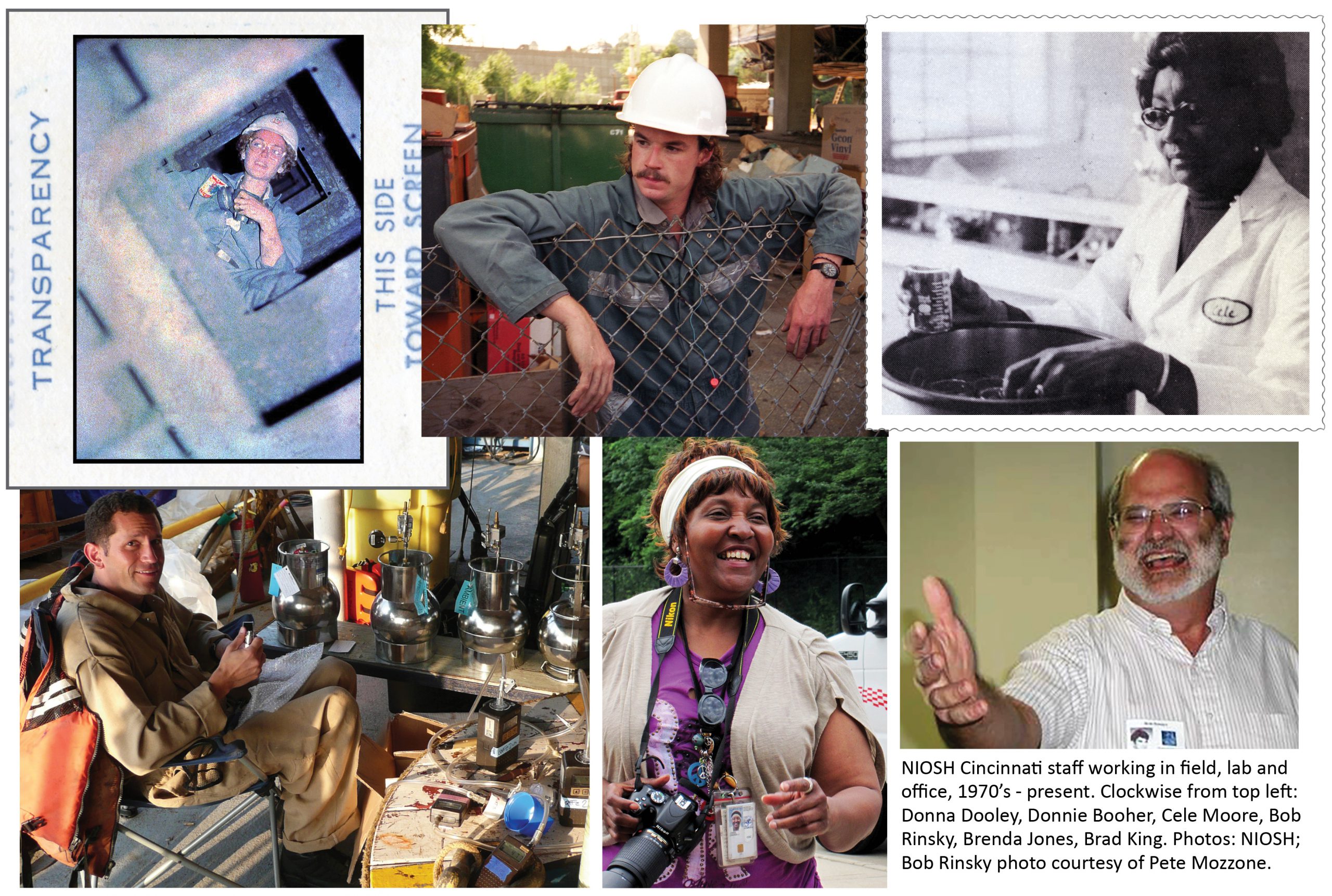
 Barbara L. Jenkins, MA, CA, is a Public Health Analyst in the NIOSH Division of Field Studies and Engineering and a Certified Archivist.
Barbara L. Jenkins, MA, CA, is a Public Health Analyst in the NIOSH Division of Field Studies and Engineering and a Certified Archivist.
This blog is part of a series for the NIOSH 50th Anniversary. For more information visit our website.
Part II References (in order used in blog)
The President’s Report on Occupational Safety and Health, Employment Safety and Health Guide, May 22, 1972.
NIOSH Directors, NIOSH Science Blog, Tisdale-Pardi, J., Feb. 21, 2021.
Benzene History interview of Robert (Bob) Rinsky by Jessica Rinsky, 2020 (manuscript).
“The Beginning of the Science Underpinning Occupational Health,” J.W. Cherrie, Ann. Occup. Hygiene, 47, 3, pp. 179-185, 2003.
“CDC History: NIOSH Cincinnati,” CDC Connects (CDC Intranet), January 18, 2007.
Wars and Scars: The Story of Compassion and Service for our Nation’s Disabled Veterans; A History of the Disabled American Veterans, T. Wilborn and D. Autry, 2006. For Idento-Tags, see Chapter 3, pp. 25-26: Disabled American Veterans History – DAV Veterans Assistance Services – A Legacy of Service, Hope for the Future
“100,000 Keys Returned Yearly by DAV,” Disabled American Veterans Semi-Monthly, Sept. 23, 1952, p. 8:
“Plum refuses to drop for Chicago: NIOSH site-selection delay welcome news,” Wheat, W.D., Cincinnati Enquirer, June 8, 1977, p. 37.
“NIOSH facility gets nod to stay in Queen City,” Wheat, W.D., Cincinnati Enquirer, May 12, 1978, p. 1.
“Personal Notes,” The Employees’ Voice, AFGE Local 3840, Nov. 1983, p. 6.
“Quality Food, Service: Employees Ask U.S. to Leave Cafeteria Alone, But It May Be Taken From Immigrants,” Kaufman, B.L., Cincinnati Enquirer, July 23, 1977, C-1.
“Meatloaf for Lunch, Mozart for Dinner,” Cincinnati Magazine, July 1977, p. 121.
“Best and Worst of Cincinnati,” Cincinnati Magazine, October 1980, p. 46; October 1984, p. 57; October 1989, p. 117; October 1993, p. 86.
“Changes at Ridge Cafeteria,” The Employees’ Voice, AFGE Local 3840, Sept./Oct. 1983, p. 4.
“84 Things You Can Do Only in Cincinnati,” Cincinnati Magazine, March 1984, p. A-16.
“Light Bite,” (in Dining section), Cincinnati Magazine, January 1985, p. D-37.
“Culinary Artists Craft Real Food,” Cincinnati Enquirer, June 19, 1994, p. 168.
“Special Feature Section: The Dedication of the Alice Hamilton Laboratory for Occupational Safety and Health,” Applied Industrial Hygiene, 2:3, F-27-F-36, DOI: 10.1080/08828032.1987.10389803
https://doi.org/10.1080/08828032.1987.10389803
Alice Hamilton and the Development of Occupational Medicine – American Chemical Society (acs.org) Alice Hamilton resource and National Historic Chemical Landmark website
Posted on by

